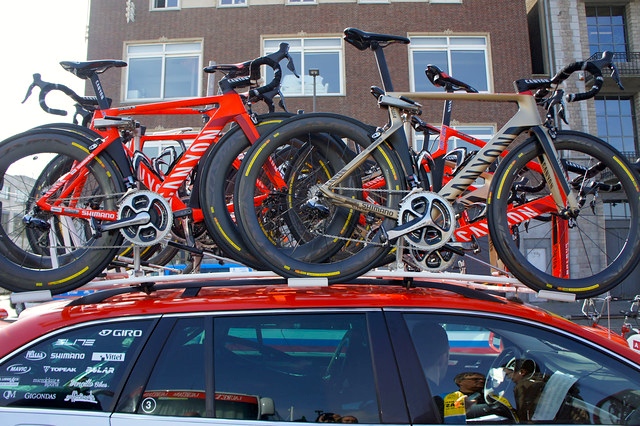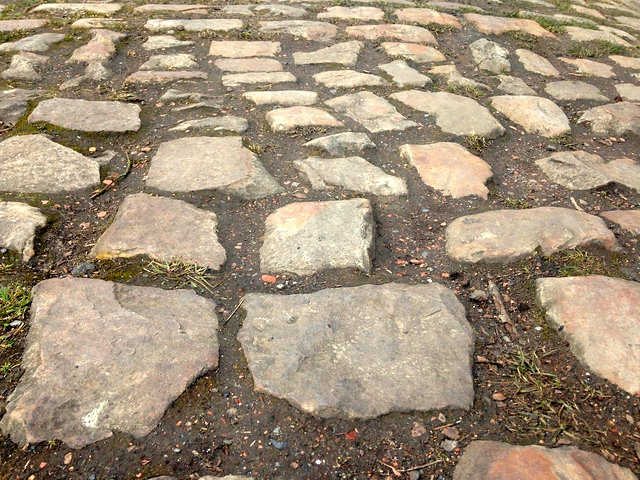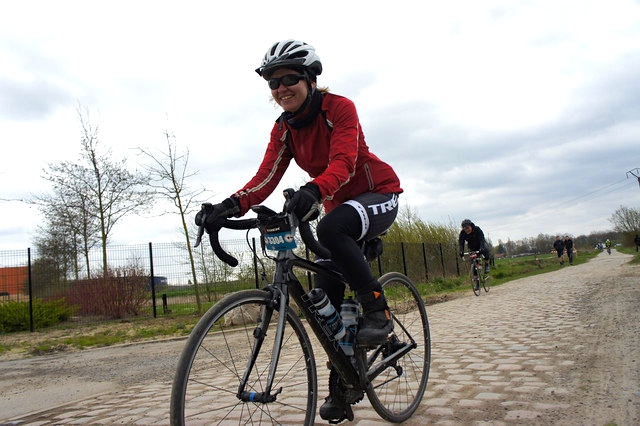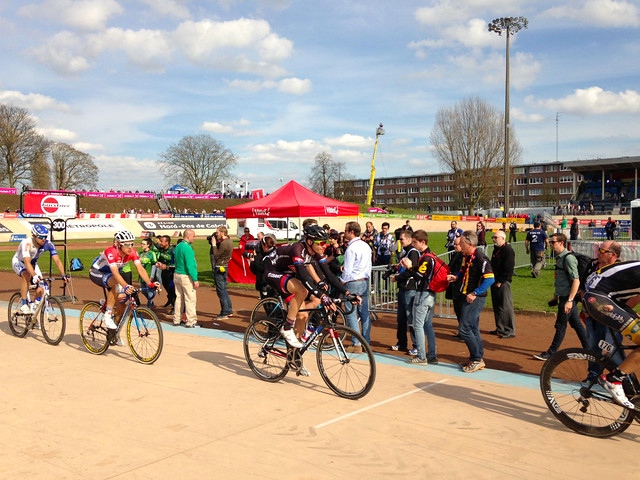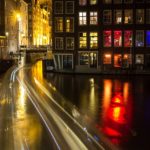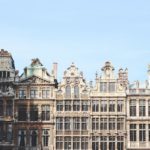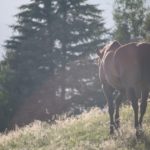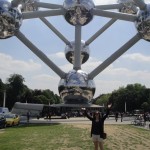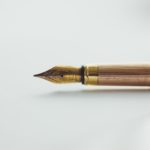Riding As If My Life Depends On It
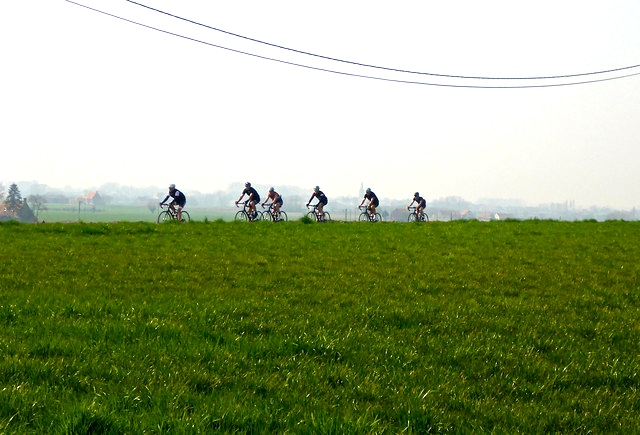
I grip the handlebars of the black Trek Domane bicycle I am riding as if my life depends on it. My brain seems to rattle against my skull. I think the ground beneath me must be moving, quaking. I can barely see. I follow close behind four crazy British guys I met a few days before, intent on staying on their wheels. We are in Belgium riding the cobbles.
Each April, Belgium is host to a series of professional bike races known as the Cobbled Classics. The Tour of Flanders, or Ronde Van Vlaaneren, is considered to be the most difficult race. The course runs 264.9 kilometers from Bruges to Oudernaarde over the nastiest cobbled climbs imaginable. It is a race that wears down even the strongest riders. The hills, though not long, are extraordinarily steep and deadly narrow. There is no rhythm to be found while riding a section of pave, or cobbles, uphill; only brute force propels. Paris-Roubaix, another of the cobbled classics, is also known as “L’Enfer du Nord” (The Hell of the North).
There is no rhythm to be found while riding a section of pave, or cobbles, uphill; only brute force propels.
The Brits and I finally hit a smooth section of country road outside of Bruges. We all sigh with relief.
“Damnnnn! Cobbles!” exclaims Farley. Farley is the ringleader and a self-proclaimed “bad boy.”
“That was amazing,” says Nick, “Though I can’t feel my hands.”
I keep my wheel between the two of them, coasting easily in their draft. Behind me are Gerry and Lawrence. Gerry is the handsome one with a Cockney accent so thick I can barely understand his English at times. Lawrence is the “smart one” and a bit moody. And then there’s me, the crazy American girl who thought it was a good idea to come to Belgium and ride the cobbles and two of the hardest race courses in pro cycling.
“You know,” Farley says, “you’re pretty fast for a girl.”
The next morning we are up early. None of us has much to say. Nick obsessively checks the weather forecast on his phone. “Rain. Just in the morning, though,” he reports.
A soft steady rain falls as we pack our pockets with food at the start. The sun has yet to emerge from the clouds. I decide that it’s better to not think about the whole ride at once but just the first 25 kilometers. I’ll get through the first 25 kilometers and then reassess.
“Ready?” Nick, asks.
“Let’s do it.” Farley says.
The first fifteen kilometers aren’t too bad. I keep up with the Brits. I can’t see very well because my glasses are spotted with water and mud but it’s okay as long as I stay close to the wheel in front of me. There are lots of other riders around us, speaking various languages. All of them are men. I wonder where the women riders are.
Once the cobbles come, I can no longer keep up with the Brits. I continue on as well as I can. I didn’t do much research before coming on this trip. I knew about cobbles but I didn’t really know about cobbles. There is no good way to explain what riding a bicycle as fast as you can on cobbles feels like. It is a weird little circle of hell where nothing is stationary; there is no point to fix your eyes on because every point vibrates at an obscene rate. I had no idea how slippery a cobble could be when covered in a thin coating of Belgium mud. I never fall though and I never walk – which is more than can be said for a lot of the riders. I still don’t see any other women.
The following day – when the pros hit the course – is bright and almost warm. The race starts in Bruges and I wander down to the main square early to see the festivities. People mill about and wave yellow flags with a crazy black graphic of a beast I can only assume is the Hell of the North.
Once the riders are off, the Brits and I pile back into the van for a day of race chasing and viewing. The main concern of the men as we set out is avoiding the women’s field lest we get ‘stuck’ watching them and miss the men.
Riding As If My Life Depends On It.
“Women’s bike racing isn’t as exciting as men’s,” Farley says, “They’re just not as strong.”
Cyclists are a slightly insane group of people. Professional cyclists are downright crazy. All doping aside, the physical power and strength of the pros is unfathomable. These men are actually propelling their bikes forward at speeds of up to 35 miles per hour. I watch them as they push up the Koppenberg, one of the steepest cobbled sections in the race. I am so close to the edge that if I were to reach out I could touch them as they fly by. I wonder if their speed is fast enough to suspend them slightly above the cobbles. I am in love with each and every one of them.
“Women’s bike racing isn’t as exciting as men’s,” Farley says, “They’re just not as strong.”
The Brits and I watch the final hours of the race at a restaurant and VIP viewing spot at the top of a hill by the forest in Muziekbos. There are some women here, though all seem to be with male companions.
“Are you here with your husband?” a man in a baseball cap and blue polo shirt asks me. I shake my head and move away from him toward the frites. As the afternoon wears on I am asked that same question five more times.
The next day the Brits and I are once again in the van, headed to the start of another race, The Schelarprijs. We are supposed to meet some of the pro racers. Upon arriving, we are ushered inside a roped off area set up around a tour bus. The team members are gracious, greeting us all, posing for a few photos, and giving autographs. As the last one rolls away, Dirk, the race director for the team exits the bus. Dirk has been in the business for a long time. Some call him a legend.
“Hello,” I say, “I’m Vanessa.” I reach out to shake his hand. His handshake is limp.
“Um, hello. I’m sorry. Are you here with your husband?” he asks.
“No,” I say, “I’m not. I wanted to ask you what you thought about the push for gender equality in cycling.”
“I’m sorry. Your name again? And this is your husband?” he points to Lawrence who is standing next to me. He shakes Lawrence’s hand, then continues on down the line of men next to me. He never looks in my direction again.
Saturday morning we are up early and on our way to the Roubaix Velodrome where we will start and end our version of Paris-Roubaix. I have an intense head cold that came on the day before and I’m determined to do the whole ride.
A light rain is falling as we arrive in Roubaix. We decide to wait a bit to start riding in hopes that it will stop. A half an hour later, our waiting pays off and we head for the start. I stay with the Brits for about twenty kilometers before I fall back and find myself cycling alone into a nasty head wind. It never lets up.
The cobbled sections are long and unrelenting: as soon as I exit one and gain my momentum and breath, another appears. A lot of riders seem to stop to rest at the end of each pave portion but I just push on. As the day wears on the wind is joined by a lashing cold rain. Mud begins to cake on my bike and shoes and face. I never think of stopping. Every once in awhile, I find myself behind a couple riders and I can draft off for a bit, resting. I find it difficult to find someone going at a similar pace as myself: they are either too fast or too slow. So, solo, I push on. I see one other woman.
“Are you here with your husband?” a man in a baseball cap and blue polo shirt asks me.
At one point, while cycling along a cobbled section in the middle of a field, the cross wind is so strong that it almost sends me into the ditch. I watch riders fall around me, get flats, drop chains. I keep going. My legs hurt. My hands hurt. Everything hurts but with each section of pave, I get bolder and push harder and faster through it. If only so the pain won’t last as long. I finish the entire 92-mile course. No one I know is at the finish to greet or congratulate me but a Paris-Roubaix marshal gives me a double thumbs up and a “good job.” Back at the van, on the side of street, I sink to a sitting position. I lean against the brick and cry silent tears of fatigue and pain, relief and pride. Someone, Gerry I think, finally comes out to help me up.
The next day brings bountiful sunshine as we watch the pros conquer the Hell of the North. We are in the Velodrome to see the finish, so close again that I can see the leg muscles of the racers rippling. I am transfixed watching the calf muscles of the men as they go by. I think that there is a touch of godliness in those muscles and I find myself worshipping them just a little.
On my last day in Belgium, I go out for a ride on my own. I have mixed feelings about my time here. I am proud and happy to have cycled so much of the legendary routes but I am also a bit sad. I can’t forget the persistent question: “Are you here with your husband?”
Riding As If My Life Depends On It.
In New York City, where I live, I race on an amateur level with a strong and amazing group of women. Through the efforts of local supporters, most of the races in the NYC area now offer equal prize money for men and women. Even so, it is not rare to hear comments such as, “The women don’t race as far as the men. They’re not as strong. They’re not the main event.”
I suppose cycling has decades of gender prejudice to traverse before there can be equality in the sport. I like to think that progress is being made and that I am part of that progress, one determined pedal stroke at a time.
Riding As If My Life Depends On It photos by Vanessa N and Unsplash.

